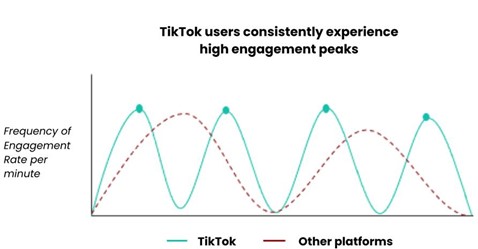Resonance -- A Key Factor for Ad Effectiveness

Have you ever seen an opera singer shatter a wine glass simply with their voice, the same force behind this phenomenon can also make bridges wobble alarmingly -- this force is called resonance and it can have a major input in ad effectiveness too. To understand the value of resonance in ad effectiveness, we have to look at the value of attention and engagement in how well an ad communicates with its consumers.
Engagement and attention are sometimes used interchangeably, but they represent two distinct concepts. What is the difference between attention and engagement? In 2002, the Advertising Research Foundation defined attention as the degree to which those exposed to advertising focus on it. Engagement expands on this by incorporating our brain's processing and reaction to the ad, or, to put it another way, Attention x Resonance = Engagement. This definition also indicates that attention is a pre-exposure ad metric, while ad engagement is a post-exposure KPI including our sentiments and how we start to react or internalize an ad. Let's look at each of these in turn.
Attention is the selective focus of the brain potentially processing something. In advertising, it depends on the intention of the audience and the creativity of the message. Research commissioned by TikTok found creative elements that feel native to the platform generate longer watch time: featuring real people (+9%), remixing a TikTok trend (+14%) and crafting a creative story (+16%)1. On TikTok, users experience a sound-on, full screen and highly entertaining stream of community-generated content, and the ability to skip content that's not interesting to them allows for strong active attention, manifested as frequent and consistent interaction with content2.

Resonance is the direct connection between content and consumers' interests, background and culture. Many digital platforms harness user preferences that have been expressed through interactions with the content and branded advertising. For instance, on TikTok, 52% of users said the ForYou page is an "effortless place to entertain myself"3. In a recently independent study about social-media influencers, university researchers concluded a key driving force of TikTok's strong interaction (e.g. likes, reactions, comments and shares) between its audience and the influencers was TikTok's drive for "authenticity and creative expression". When advertisers are able to tap into these communities and connect with their audiences, attention is earned, not forced, and their message has the opportunity to resonate. As a result, consumers are inspired to take action.
Engagement measures the quality of attention and involvement after an ad's exposure to the consumer. With various definitions of attention in the marketplace, comes varying measurement approaches. These solutions track different KPIs and can heavily affect a platform's measured "attention quality". Consequently, "attention" is not always a reliable predictor of audience engagement or business outcomes. A recent Eyesquare study shows that visual attention (i.e., view duration) is not the same as meaningful attention. Ad formats with longer average view times don't always lead to better business outcomes (eg, Ad Recall, Brand Recognition). For marketers, an effective ad view should serve as a starting point for further exploration in the consumers' purchase journey. According to a Post-purchase Survey study done by Fairing, TikTok influences consumer paths to purchase by making up 15% of product discoveries across media channels, emails and word of mouth. As users experience a myriad of content across channels, advertising needs to not only grab the audience's active attention through creativity, but also build connections with their consumers to breakthrough and drive outcomes.
Diminishing Return between Ad Attention and Its Outcomes
The ad industry generally agrees attention metrics can and are being used for evaluating creatives and ad effectiveness according to the research conducted by the ARF. However, more studies are needed to understand how attention can be used to predict media impact, especially in conjunction with other more established media KPIs such as the lifts in a brand's attitudes and sales.
As mentioned early, while longer view times generally lead to higher brand KPIs, the relationship between view duration and outcomes are not linear, especially when brands factor in creative quality, audience difference and ad format nuances. For instance, two Australian academics recently showed this to be the case for online banners. As part of their review, they showed if an ad could keep respondents' attention on a banner ad for 1 second, ad recall could be as high as 40%, but if their attention extended to 4 seconds, then 7 out of 10 people recalled seeing an ad, boosting Ad Recall by 1.75x to 70%.
Specifically, for TikTok, research conducted by its Marketing Science unit suggests 50% of the impact from a TikTok ad is realized in the first 2 seconds, and the first 6 seconds captures 90% cumulative impact on Ad Recall and around 80% for Awareness4. Moreover, the longer videos continue to play, the audience size tends to decrease. Marketers should be aware of the unintended consequences and tradeoffs between viewing duration and reach, as well as cost per reach. So, more is not always more.

Additionally, in a fragmented media landscape, attention should not be studied in silo. A brand's marketing mix highly influences attention on platforms. In a research study with Neuro-Insight, it was observed that advertising primed to perform on TikTok, especiallywhen ads on TikTok embrace the platform's native style, seamlessly blend with the content following the ads.
UM's neuroscience studies also validate this showing that while short TV and online ads can be powerful, for maximum effect, brands should consider building for the platforms. TV tends to be a more lean-back environment where people often enjoy watching the screen in a more relaxed manner. By contrast, the viewer experience on Online, mobile phones, laptops etc., is more lean-in. Online's lean-in experience means digital video ads can engage the viewer more quickly and communicate more speedily than TV.
We're not alone, and we're not the first, to identify the power of Resonance as an important factor in ad effectiveness – major advertising doyen, Randall Beard, highlighted the importance of Resonance in his blog back in 2015 which he described as Reach x Resonance = Reaction. Given the accelerating fragmentation of the media marketplace, which is becoming increasingly divergent in many ways, we believe the industry needs to urgently work towards a common yet flexible standard of advertising exposure and effectiveness.
This articke was written by Graeme Hutton, SVP, Group Partner, Research, UM & Marketing Science Team, TikTok
1 TikTok Marketing Science US SMB Creative Effectiveness 2022 conducted by Lumen
2 TikTok Marketing Science Global Information Density Study 2021 conducted by Neuro-Insight
3 TikTok Marketing Science Global Entertaining Ads 2022 conducted by Marketcast
4 TikTok Marketing Science US Value Of A View 2021 conducted by MediaScience
Click the social buttons to share this story with colleagues and friends.
The opinions expressed here are the author's views and do not necessarily represent the views of MediaVillage.org/MyersBizNet.

